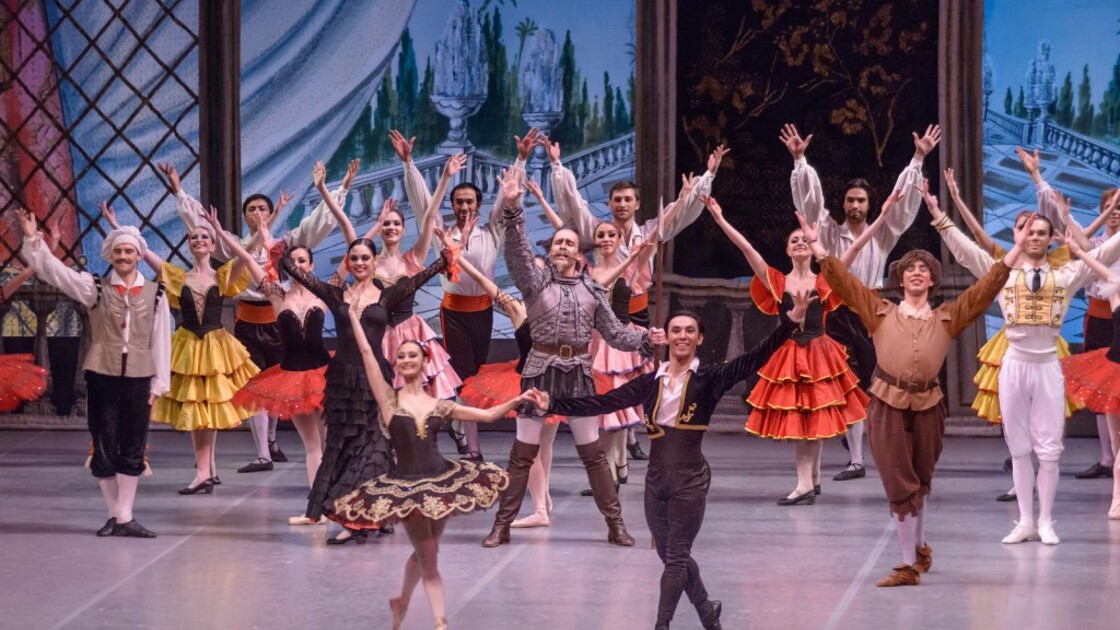EDMOND—The Moscow Festival Ballet performed two ballets on January 27 and 28 in Armstrong Auditorium. Audiences of 702 and 539 braved cold temperatures to watch Sleeping Beauty the first night, and Don Quixote the second night. Although the Moscow troupe had never graced the Armstrong Auditorium stage before, 10 of its 50 dancers had actually performed there with the Russian National Ballet in 2011.
In Sleeping Beauty, dancers portrayed the celebration of the 16th birthday of Princess Aurora (Maria Sokolnikova). The princess danced and twirled in the court while peasant girls in pastel colors waved flower garlands behind her, and four potential suitors each offered her a rose. Throughout the scene, she returned to a pose with one leg raised and bent behind her and one arm curved overhead, meant to convey youthful uncertainty. In the midst of the revelry, the hunched, cackling, disguised wicked fairy Carabosse (Alexander Dayev) offered Aurora a bouquet of flowers. Aurora gleefully seized it, pricking her finger on a poisoned spindle hidden within and collapsing to the floor. To prevent certain death, the Lilac Fairy intervened by casting her and everyone else in the court into a deep slumber. The act ended with the Lilac Fairy summoning a forest of thorns and shrubs to shroud the court.
Act II depicted a neighboring kingdom 100 years later. Prince Charming (Eldar Sarsembayev) longed for true love. As he wandered about in the forest, the Lilac Fairy sailed up and showed him a spectral image of Princess Aurora, who danced lyrically and romantically amongst a troupe of fairies and nymphs, enchanting the prince. The Lilac Fairy and Prince Charming sailed across the lake to the castle where Princess Aurora remained comatose. The prince kissed his true love, waking her at long last.
Act III invited the audience into a vast hall with towering columns and a circular gold staircase. Puss ‘n Boots, Bluebeard, Goldilocks and Little Red Riding Hood all danced and entertained the wedding guests. Prince Charming and Princess Aurora then performed a regal couple’s dance. The prince jumped, spun and supported his lady’s pirouettes before dipping her into the famous fish dive pose. Finally, the Lilac Fairy gave her blessing to the happy couple.
Audience members gave a standing ovation, clapping loudly and waving goodbye to the performers as the curtains closed. Immediately afterward, one satisfied concertgoer placed pink and yellow carnations on the stage.
The following night, the troupe opened up the prologue to Don Quixote (Dmitry Romanov) with the title character in his study reading books about chivalry and knighthood. Overtaken by daydreams of adventure, Quixote appointed his servant Sancho Panza (Alexander Yakolev) as his squire and set out to find his desired and entirely fictional lady, Dulcinea.
In Act I, Quixote and Panza, a portly glutton, mingled in a bustling marketplace where lovers Basilio (Sarsembayev) and Kitri (Sokolnikova) enjoyed one another’s company. Kitri’s father burst into the scene to voice disapproval of Basilio, a lowly barber, and declaring that Kitri should marry Camacho, a rich older gentleman. Quixote, who saw his beloved Dulcinea in Kitri, helped the couple flee the marketplace.
Act II showed Basilio and Kitri taking refuge with a band of gypsies, who put on a puppet show to honor Quixote. However, Quixote took the play seriously and imagined he was being besieged by evil forces. He barged onstage, destroyed the theater and attacked a windmill in the distance, all to supposedly defend the honor of Kitri. The windmill assault left Quixote unconscious as the act came to a close.
During intermission, one guest was overheard commenting on the quality of the ballet and other performances in Armstrong Auditorium. He marveled at the level of talent among local Philadelphia Church of God members and youth displayed during the showing of David—The Endless Throne Begins in December; he also remarked that no other venue combined such quality staffing, architecture and performers.
Back on stage, Act III opened with Kitri’s enraged father tracking down his runaway daughter in a tavern and dragging her to a marriage ceremony with Camacho. In response, Basilio feigned suicide and fell to the ground, supposedly bleeding to death. Kitri convinced Lorenzo to give Basilio his blessing since he would die soon anyway. Immediately, Basilio jumped up and joyously declared his trickery. Basilio and Kitri were married in a palace amid much fanfare. Quixote realized that Kitri was not his Dulcinea, so he and Panza departed to find the fictional damsel.
In between acts, several patrons complimented the auditorium staff members. “You guys look sharp!” one concertgoer said. Another said she was thankful for the men who helped “lost little ladies” like herself find their seats. Other concertgoers voiced amazement at the beauty of the venue. “It’s just fabulous, it’s fabulous!” one patron said. Another declared, “I love it, love it, love it!”
Armstrong Auditorium has hosted two major Russian ballet theaters since it opened in September 2010. In 2011, the Russian National Ballet performed Swan Lake, and in 2013 it returned to perform Cinderella and Romeo and Juliet on back-to-back nights. The Moscow Festival Ballet, which formed in 1989, has 14 performances in 11 states remaining on its current U.S. tour, which concludes in May.
“It’s sort of become a tradition now: January is ballet month at Armstrong, and we’re happy to say it’s been a very great success,” Armstrong International Cultural Foundation marketing director Shane Granger said. “We’ve just started booking them as a regular part of our series now. I think Oklahomans love ballet, and these dancers are the real deal. They are world-class.”
